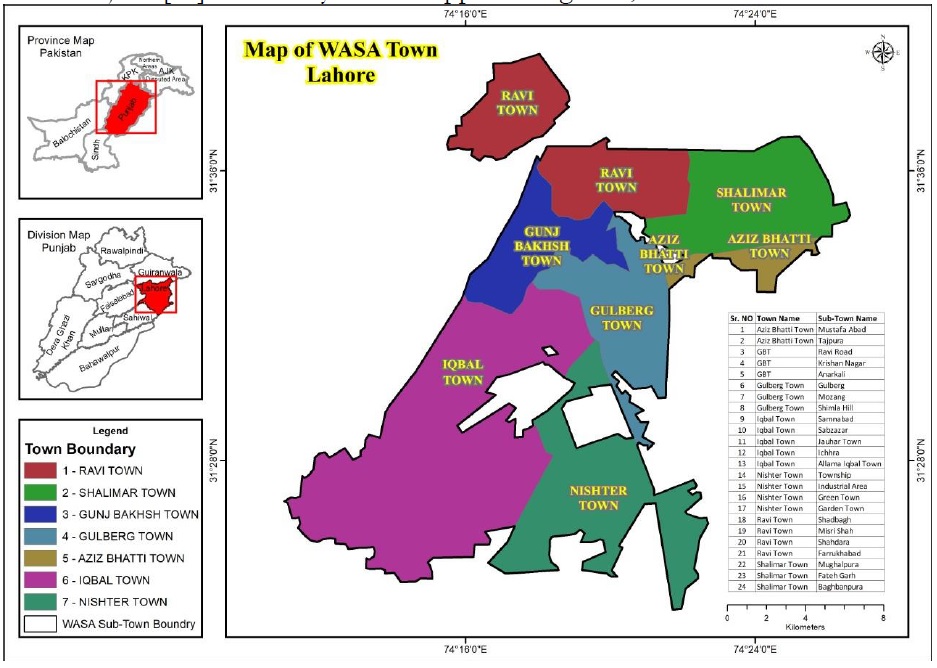Critical Study of Groundwater Quality of Metropolitan Lahore Using Geo-Spatial Techniques
Keywords:
pH, Turbidity, Chloride, Water Quality, GISAbstract
Lahore is famous for its rapid urban growth providing bread and butter to around 11 million population. Availability of clean drinking water to general public is the responsibility of the state. Pakistan ranks at 80 in terms of providing standard drinking water to people. This research is based on monitoring the temporal changes in water quality of various towns of Lahore for the years 2009-2019. Various water quality parameters e.g., pH, alkalinity, calcium, magnesium, hardness, turbidity, chloride, Total Dissolved Solid (TDS), Electric Conductivity (EC) and hardness were examined, and the spatial trend was mapped. Primary data about these parameters was collected from water and sanitation authority Lahore and the interpolation was applied to examine trend in variations of various levels of these parameters for a period from 2009 to 2019. The results show that pH, alkalinity, hardness and turbidity levels in most of towns were below the acceptable limit in comparison to World Health Organization permissible standards. We found that industrial boom, poor sanitation, seepage of sewerage water and its addition in ground water has declined the overall quality of drinking water. Local government must take blunt steps to improve the quality of drinking water otherwise the overall situation may lead to become drastic in near future.
References
Bureau of Indian Standards (BIS). Specification for drinking water. New Delhi,
India: Food and Agricultural Division Council; 2012.
Central Pollution Control Board (CPCB). Guide manual: water and waste water.
New Delhi, India: Central Pollution Control Board; 2013.
Available: http://www.cpcb.nic.in/upload/Latest/Latest_67_guidemanualw&wwanalysis.pdf.
World Health Organization (WHO). Guideline for drinking water quality. 2012.
Ochuko U, Thaddeus O, Oghenero OA, John EE. A comparative assessment of
water quality index (WQI) and suitability of river Ase for domestic water supply in urban
and rural communities in Southern Nigeria. Int J Human Soc Sci. 2014;4(1):234–45.
Tyagi S, Sharma B, Singh P, Dobhal R. Water quality assessment in terms of Water
Quality Index. Am J Water Resour. 2013;1(3):34–8.
Chowdhury RM, Muntasir SY, Hossain MM. Water Quality Index of water bodies
along Faridpur-Barisal Road in Bangladesh. Glob Eng Tech Rev. 2012;2:1–8.
Akter T, Ali ARMM. Factors influencing knowledge and practice of hygiene in
Water, Sanitation and Hygiene (WASH) programme areas of Bangladesh Rural
Advancement Committee. Rural Remote Health. 2014;14:2628. Online.
Dey NC, Rabbi SE. Studies on the impact of BRAC WASH-1 interventions: an
overview. In: achievements of BRAC Water, Sanitation and Hygiene programme towards
Millennium Development Goals and beyond. Dhaka: BRAC; 2013.
Rabbi SE, Dey NC. Exploring the gap between hand washing knowledge and
practices in Bangladesh: a cross-sectional comparative study. BMC Public Health.
;13:89.
Dey NC, Akter T. Women in water-hygiene and sanitation management at
households in rural Bangladesh: changes from baseline to end line survey. In: achievements
of BRAC Water, Sanitation and Hygiene programme towards Millennium Development
Goals and beyond. Dhaka: BRAC; 2013.
UNICEF. First annual high level meeting for sanitation and water for all aims to be a
watershed for reaching the MDG targets. 2010.
Available: http://www.unicef.org/bangladesh/media_6193.htm
George CM, Zheng Y, Graziano JH, Rasul SB, Hossain Z, Mey JL, et al. Evaluation
of an arsenic test kit for rapid well screening in Bangladesh. Environ Sci Technol.
;46(20):11213–9.
World Health Organization (WHO). pH in drinking water. Guidelines for drinking
water quality. Geneva: World Health Organization; 1996.
Available: http://www.who.int/water_sanitation_health/dwq/chemicals/en/ph.pdf.
Ambica A. Groundwater quality characteristics study by using water quality index in
Tambaram area, Chennai, Tamil Nadu. Middle East J Sci Res. 2014;20(11):1396–401.
Rahman MM, Mukherjee D, Sengupta MK, Chowdhury UK, Lodh D, Ranjan C, et al. Effectiveness and reliability of arsenic field testing kits: are the million dollar screening projects effective or not. Environ Sci Technol. 2002;36(24):5385–94.
Ikonen, J., Pitkänen, T., & Miettinen, I. (2013). Suitability of Optical, Physical
and Chemical Measurements for Detection of Changes in Bacterial Drinking Water
Quality. International journal of environmental research and public health, 10(11), 5349-
Retrieved 2015
Sadeghioon, A. M., Metje, N., Chapman, D. N., & Anthony, C. J. (2019, February
. Smartpipes : Smart Wireless Sensor Networks for Leak Detection in Water
Pipelines. Journal of Sensor and Actuator Networks, 3, 64-78. Retrieved 2015, from
http://www.mdpi.com/2224-2708/3/1/64
Deb, A., mccammon, S. B., Snyder, J., & Dietrich, A. (2010). Impacts of Lining
Materials. USA: Water Research Foundation and Drinking Water. Retrieved 2015, from
http://www.waterrf.org/publicreportlibrary/4036.pdf
WWF. (2007). Pakistan's Waters At Risk ; Water and health related issues in
Pakistan & Key Recomendations. WWF. Retrieved 2015, from
http://www.ircwash.org/sites/default/files/WWF-Pakistan-2007-Pakistans.pdf
Danee , .. J., & Helen, .. S. (2015, May). Spatial Mapping of Groundwater Quality
using GIS. International Journal of Emerging Technology and Advanced Engineering,
(5), 265-270. Retrieved July 2015, from
http://www.ijetae.com/files/Volume5Issue5/IJETAE_0515_46.pdf
Gallagher, L. G., Webster, T. F., Vieira, V. M., & Aschengrau, A. (2010). Using
Residential History and Groundwater Modeling to Examine Drinking Water Exposure
and Breast Cancer. Environmental Health Perspectives. Retrieved from
https://www.ncbi.nlm.nih.gov/pmc/articles/PMC2898849/
Reza, R., & G. , S. (2010). Assessment of Groundwater Quality Status by Using
Water Quality Index Method in Orissa, India. World Applied Sciences Journal, 9(12),
-1397.




